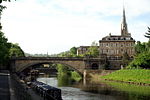Bear Flat

Bear Flat is a neighbourhood within the city of Bath, Somerset, England, to the south of the city centre and to the west of Beechen Cliff (a heavily wooded escarpment on the northern side of Lyncombe Hill which features in Jane Austen's Northanger Abbey). It forms the southern part of the Widcombe and Lyncombe electoral ward. The Wellsway road (A367) to Shepton Mallet, runs through Bear Flat, forming part of the ancient British Roman Fosse Way. This was originally the main pilgrimage route from Bath and its abbey, to the nearby ecclesiastical centres of Wells and Glastonbury. Bath is a hilly city and the term 'Flat' may be derived from the way the district is defined by a short plateau at the top of the steep Wells Road and Holloway routes out of the city centre, which forms the local business district. 'Bear' has nothing to do with the animal but is believed to be a contraction of an Anglo-Saxon name 'Berewick' - 'Bere' meaning Barley and 'Wick' being a settlement - a settlement near a barley field. Such a field would have been part of Barrack Farm, which was located in the area but demolished in the 19th century to make way for housing. Physical evidence of the former farm exists at the top of the Wellsway at Odd Down with a pair of houses known as Barrack Farm Cottages.
Excerpt from the Wikipedia article Bear Flat (License: CC BY-SA 3.0, Authors, Images).Bear Flat
Wellsway, Bath Bear Flat
Geographical coordinates (GPS) Address Website Nearby Places Show on map
Geographical coordinates (GPS)
| Latitude | Longitude |
|---|---|
| N 51.3738 ° | E -2.3666 ° |
Address
The Bear
Wellsway 8-10
BA2 3AQ Bath, Bear Flat
England, United Kingdom
Open on Google Maps









